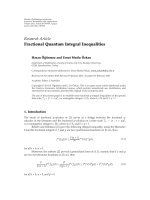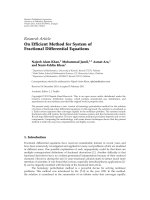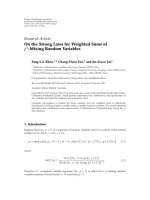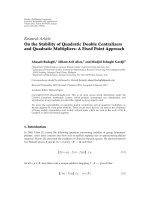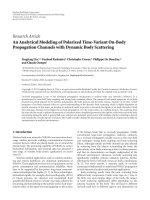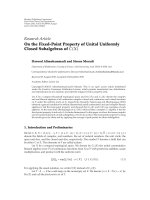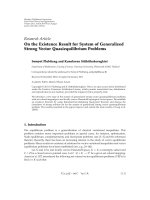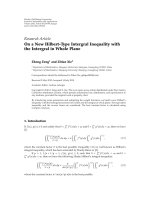báo cáo hóa học:" Research Article On Some Integral Inequalities on Time Scales and Their Applications" pdf
Bạn đang xem bản rút gọn của tài liệu. Xem và tải ngay bản đầy đủ của tài liệu tại đây (513.08 KB, 13 trang )
Hindawi Publishing Corporation
Journal of Inequalities and Applications
Volume 2010, Article ID 464976, 13 pages
doi:10.1155/2010/464976
Research Article
On Some Integral Inequalities on Time Scales and
Their Applications
Run Xu,
1
Fanwei Meng,
1
and Cuihua Song
2
1
School of Mathematical Sciences, Qufu Normal University, Qufu, 273165 Shandong, China
2
School of Chemistry and Chemical Engineering, Qufu Normal University, Qufu, 273165 Shandong, China
Correspondence should be addressed to Run Xu, xurun
Received 15 January 2010; Revised 3 March 2010; Accepted 18 March 2010
Academic Editor: Martin Bohner
Copyright q 2010 Run Xu et al. This is an open access article distributed under the Creative
Commons Attribution License, which permits unrestricted use, distribution, and reproduction in
any medium, provided the original work is properly cited.
The purpose of this paper is to investigate some new dynamic inequalities on time scales.
We establish some new dynamic inequalities; the results unify and extend some continuous
inequalities and their corresponding discrete analogues. The inequalities given here can be used as
tools in the qualitative theory of certain dynamic equations. Some examples are given in the end
of this paper.
1. Introduction
The theory of time scales was introduced by Hilger 1 in 1988 in order to contain both
difference and differential calculus in a consistent way. Recently, many authors have extended
some fundamental integral inequalities used in the theory of differential and integral
equations on time scales. For example, we refer the reader to the papers 2–12 and the
references cited there in.
In this paper, we investigate some nonlinear integral inequalities on time scales,
which extend some inequalities established by Li and Sheng 8 and Li 9. The obtained
inequalities can be used as important tools in the study of dynamic equations on time scales.
Throughout this paper, let us assume that we have already acquired the knowledge
of time scales and time scales notation; for an excellent introduction to the calculus on time
scales, we refer the reader to Bohner and Peterson 4 for general overview.
2. Some Preliminaries on Time Scales
In what follows, R denotes the set of real numbers, Z denotes the set of integers, N
0
denotes
the set of nonnegative integers, C denotes the set of complex numbers, and CM, S denotes
2 Journal of Inequalities and Applications
the class of all continuous functions defined on set M with range in the set S. T is an arbitrary
time scale. If T has a right-scattered maximum m, then the set T
k
T −{m}; otherwise,
T
k
T. C
rd
denotes the set of rd-continuous functions; R denotes the set of all regressive and
rd-continuous functions. We define the set of all positively regressive functions by R
{p ∈
R :1 μtpt > 0,t∈ T}. Obviously, if p ∈ C
rd
and pt ≥ 0fort ∈ T, then p ∈R
.
For f : T → R and t ∈ T
k
, we define f
Δ
t as follows provided it exists:
f
Δ
t
: lim
s → t
f
σ
t
− f
s
σ
t
− s
;
2.1
we call f
Δ
t the delta derivative of f at t.
The following lemmas are very useful in our main results.
Lemma 2.1 see 4. If p ∈Rand fix t
0
∈ T, then the exponential function e
p
·,t
0
is for the unique
solution of the initial value problem
x
Δ
p
t
x, x
t
0
1 on T.
2.2
Lemma 2.2 see 4. Let t
0
∈ T
k
and w : T × T
k
→ R be continuous at t, t,wheret ≥ t
0
.
Assume that w
Δ
t, · is rd-continuous on t
0
,σt. If for any ε>0, there exists a neighborhood U of
t, independent of τ ∈ t
0
,σt, such that
w
σ
t
,τ
− w
s, τ
− w
Δ
t, τ
σ
t
− s
≤ ε
|
σ
t
− s
|
,s∈ U, 2.3
where w
Δ
denotes the derivative of w with respect to the first variable, then
g
t
:
t
t
0
w
t, τ
Δτ
2.4
implies
g
Δ
t
:
t
t
0
w
Δ
t, τ
Δτ w
σ
t
,t
.
2.5
The following theorem is a foundational result in dynamic inequalities.
Lemma 2.3 Comparison Theorem 4. Suppose u, b ∈ C
rd
,a∈R
;then
u
Δ
t
≤ a
t
u
t
b
t
,t≥ t
0
,t∈ T
k
,
2.6
implies
u
t
≤ u
t
0
e
a
t, t
0
t
t
0
b
τ
e
a
t, σ
τ
Δτ, t ≥ t
0
,t∈ T
k
.
2.7
Journal of Inequalities and Applications 3
The following lemma is useful in our main results.
Lemma 2.4 see 7. Let a ≥ 0,p≥ q>0,then
a
q/p
≤
q
p
K
q−p/p
a
p − q
p
K
q/p
,K>0.
2.8
3. Main Results
In this section, we study some integral inequalities on time scales. We always assume that
p, q,r, m are constants, p ≥ q>0,p≥ m>0,p≥ r>0, and t ≥ t
0
,t∈ T
k
.
Theorem 3.1. Assume that u, a, b, f, g, h ∈ C
rd
; ut,at,bt,ft,gt, and ht are nonnega-
tive; then
u
p
t
≤ a
t
b
t
t
t
0
f
s
u
q
s
g
s
u
r
s
s
t
0
h
τ
u
m
τ
Δτ
Δs, t ∈ T
k
, 3.1
implies
u
t
≤
atb
t
t
t
0
B
τ
e
Aτ
t, σ
τ
Δτ
1/p
,K>0,t∈ T
k
,
3.2
where
A
t
q
p
K
q−p/p
f
t
r
p
K
r−p/p
g
t
b
t
m
p
K
m−p/p
t
t
0
b
τ
h
τ
Δτ,
B
t
f
t
q
p
K
q−p/p
a
t
p − q
p
K
q/p
g
t
r
p
K
r−p/p
a
t
p − r
p
K
p/r
t
t
0
m
p
K
m−p/p
a
τ
p − m
p
K
m/p
h
τ
Δτ, t ∈ T
k
.
3.3
Proof. Define zt by
z
t
t
t
0
f
s
u
q
s
g
s
u
r
s
s
t
0
h
τ
u
m
τ
Δτ
Δs, 3.4
then zt
0
0, and 3.1 can be restated as
u
p
t
≤ a
t
b
t
z
t
. 3.5
4 Journal of Inequalities and Applications
Using Lemma 2.1, f or any k>0, we obtain
u
q
t
≤
a
t
b
t
z
t
q/p
≤
q
p
K
q−p/p
a
t
b
t
z
t
p − q
p
K
q/p
,
u
r
t
≤
a
t
b
t
z
t
r/p
≤
r
p
K
r−p/p
a
t
b
t
z
t
p − r
p
K
r/p
,
u
m
t
≤
a
t
b
t
z
t
m/p
≤
m
p
K
m−p/p
a
t
b
t
z
t
p − m
p
K
m/p
.
3.6
It follows from 3.4 and 3.6 that
z
Δ
t
f
t
u
q
t
g
t
u
r
t
t
t
0
h
τ
u
m
τ
Δτ
≤ f
t
q
p
K
q−p/p
a
t
b
t
z
t
p − q
p
K
q/p
g
t
r
p
K
r−p/p
a
t
b
t
z
t
p − r
p
K
r/p
t
t
0
h
τ
m
p
K
m−p/p
a
τ
b
τ
z
τ
p − m
p
K
m/p
Δτ
≤ B
t
A
t
z
t
,t∈ T
k
,
3.7
where At, and Bt are defined as in 3.3 and At is regressive obviously.
From Lemma 2.3 and 3.7,notingzt
0
0, we obtain
z
t
≤
t
t
0
B
τ
e
Aτ
t, σ
τ
Δτ.
3.8
Therefore, the desired inequality 3.2 follows from 3.5 and 3.8.
Remark 3.2. Theorem 3.1 extends some known inequalities on time scales. If q 1,r 0,ht
0, then Theorem 3.1 reduces to 7, Theorem 3.1.Ifq p, ht0, then Theorem 3.1 reduces
to 8, Theorem 3.2.
Remark 3.3. The result of Theorem 3.1 holds for an arbitrary time scale. If T R, then
Theorem 3.1 becomes the Theorem 1 established by Yuan et al. 13.IfT Z, we can have the
following Corollary.
Corollary 3.4. Let T Z and assume that ut,at,bt,ft,gt, and ht are nonnegative
functions defined for t ∈ N
0
. Then the inequality
u
p
t
≤ a
t
b
t
t−1
s0
f
s
u
q
s
g
s
u
r
s
s−1
τ0
h
τ
u
m
τ
,t∈ N
0
,
3.9
Journal of Inequalities and Applications 5
implies
u
t
≤
atbt
t−1
s0
Bs
t−1
τs1
1 Aτ
1/p
,K>0,t∈ N
0
,
3.10
where
A
t
q
p
K
q−p/p
f
t
r
p
K
r−p/p
g
t
b
t
m
p
K
m−p/p
t−1
τ0
b
τ
h
τ
,
B
t
f
t
q
p
K
q−p/p
a
t
p − q
p
K
q/p
g
t
r
p
K
r−p/p
a
t
p − r
p
K
p/r
t−1
τ0
m
p
K
m−p/p
a
τ
p − m
p
K
m/p
h
τ
,t∈ N
0
.
3.11
Corollary 3.5. Let T lZ ∩ 0, ∞, where lZ {lk : k ∈ Z,l > 0}. We assume that
ut,at,bt,ft,gt,and ht are nonnegative functions defined for t ∈ T. Then the inequality
u
p
t
≤ a
t
b
t
t/l−1
s0
f
ls
u
q
ls
g
ls
u
r
ls
s/l−1
τ0
h
lτ
u
m
lτ
,t∈ T
3.12
implies
u
t
≤
atbt
t/l−1
s0
Bls
t/l−1
τs/l1
1 Aτ
1/p
,K>0,t∈ T,
3.13
where
A
t
q
p
K
q−p/p
f
t
r
p
K
r−p/p
g
t
b
t
m
p
K
m−p/p
t/l−1
τ0
b
lτ
h
lτ
,
B
t
f
t
q
p
K
q−p/p
a
t
p − q
p
K
q/p
g
t
r
p
K
r−p/p
a
t
p − r
p
K
p/r
t/l−1
τ0
m
p
K
m−p/p
a
lτ
p − m
p
K
m/p
h
lτ
,t∈ T.
3.14
6 Journal of Inequalities and Applications
Theorem 3.6. Assume that u, a, b, f, h are defined as in Theorem 3.1, Lt, y,Mt, y : T
k
× R →
R
are continuous functions, and Lt, y is nondecreasing about the second variable and satisfies
0 ≤ L
t, x
− L
t, y
≤ M
t, y
x − y
3.15
for t ∈ T
k
and x ≥ y ≥ 0; then
u
p
t
≤ a
t
b
t
t
t
0
f
s
u
q
s
L
s, u
r
s
s
t
0
h
τ
u
m
τ
Δτ
Δs, t ∈ T
k
3.16
implies
u
t
≤
atbt
t
t
0
B
1
τe
A
1
t, στΔτ
1/p
,K>0,t∈ T
k
,
3.17
where
A
1
t
q
p
K
q−p/p
f
t
b
t
m
p
K
m−p/p
t
t
0
h
τ
b
τ
Δτ
r
p
K
r−p/p
M
t,
r
p
K
r−p/p
a
t
p − r
p
K
r/p
b
t
,
B
1
t
f
t
q
p
K
q−p/p
a
t
p − q
p
K
q/p
t
t
0
h
τ
m
p
K
m−p/p
a
τ
p − m
p
K
m/p
Δτ
L
t,
r
p
K
r−p/p
a
t
p − r
p
K
r/p
,t∈ T
k
.
3.18
Proof. Define zt by
z
t
t
t
0
f
s
u
q
s
L
s, u
r
s
s
t
0
h
τ
u
m
τ
Δτ
Δs, 3.19
then zt
0
0, and 3.16 can be written as 3.5.
Journal of Inequalities and Applications 7
Therefore, from 3.6 and 3.19, we have
z
Δ
t
f
t
u
q
t
L
t, u
r
t
t
t
0
h
τ
u
m
τ
Δτ
≤ f
t
q
p
K
q−p/p
a
t
b
t
z
t
p − q
p
K
q/p
L
t,
r
p
K
r−p/p
a
t
b
t
z
t
p − r
p
K
r/p
− L
t,
r
p
K
r−p/p
a
t
p − r
p
K
r/p
t
t
0
h
τ
m
p
K
m−p/p
a
τ
b
τ
z
τ
p − m
p
K
m/p
Δτ
L
t,
r
p
K
r−p/p
a
t
p − r
p
K
r/p
≤ f
t
q
p
K
q−p/p
a
t
p − q
p
K
q/p
t
t
0
h
τ
m
p
K
m−p/p
a
τ
p − m
p
K
m/p
Δτ
q
p
K
q−p/p
f
t
b
t
m
p
K
m−p/p
t
t
0
h
τ
b
τ
Δτ
z
t
M
t,
r
p
K
r−p/p
a
t
p − r
p
K
r/p
r
p
K
r−p/p
b
t
z
t
L
t,
r
p
K
r−p/p
a
t
p − r
p
K
r/p
A
1
t
z
t
B
1
t
,t∈ T
k
,
3.20
where A
1
t, and B
1
t are defined as in 3.18 and A
1
t is regressive obviously.
From Lemma 2.3 and 3.20,notingzt
0
0, we obtain
z
t
≤
t
t
0
B
1
τ
e
A
1
τ
t, σ
τ
Δτ.
3.21
Therefore, the desired inequality 3.17 follows from 3.5 and 3.21.
8 Journal of Inequalities and Applications
Remark 3.7. If T R, then Theorem 3.6 becomes 13, Theorem 3.IfT Z, we can have the
following Corollary.
Corollary 3.8. Let T Z and assume that ut,at,bt,ft,gt, and ht are nonnegative
functions defined for t ∈ N
0
. L, M ∈ CR
2
, R
satisfy
0 ≤ L
t, x
− L
t, y
≤ M
t, y
x − y
3.22
for x ≥ y ≥ 0 and Lt, y is nondecreasing about the second variable. Then the inequality
u
p
t
≤ a
t
b
t
t−1
s0
f
s
u
q
s
L
s, u
r
s
s−1
τ0
h
τ
u
m
τ
,t∈ N
0
3.23
implies
u
t
≤
atbt
t−1
s0
B
1
τ
t−1
τs1
1 A
1
τ
1/p
,K>0,t∈ N
0
,
3.24
where
A
1
t
q
p
K
q−p/p
f
t
b
t
m
p
K
m−p/p
t−1
τ0
h
τ
b
τ
r
p
K
r−p/p
M
t,
r
p
K
r−p/p
a
t
p − r
p
K
r/p
b
t
,
B
1
t
f
t
q
p
K
q−p/p
a
t
q − p
p
K
q/p
t−1
τ0
h
τ
m
p
K
m−p/p
a
τ
p − m
p
K
m/p
L
t,
r
p
K
r−p/p
a
t
p − r
p
K
r/p
,t∈ N
0
.
3.25
Theorem 3.9. Assume that ut,at,bt,ft,gt, and ht are defined as in Theorem 3.1, wt, s
is defined as in Lemma 2.2 such that wσt,t ≥ 0,w
Δ
t, s ≥ 0 for t, s ∈ T with s ≤ t;then
u
p
t
≤ a
t
b
t
t
t
0
w
t, s
f
s
u
q
s
g
s
u
r
s
s
t
0
h
τ
u
m
τ
Δτ
Δs, t ∈ T
k
,
3.26
Journal of Inequalities and Applications 9
implies
u
t
≤
atbt
t
t
0
B
2
τe
A
2
t, στΔτ
1/p
,K>0,t∈ T
k
,
3.27
where
A
2
t
w
σ
t
,t
q
p
K
q−p/p
f
t
r
p
K
r−p/p
g
t
b
t
m
p
K
m−p/p
t
t
0
b
τ
h
τ
Δτ
t
t
0
w
Δ
t, s
q
p
K
q−p/p
f
s
r
p
K
r−p/p
g
s
b
s
m
p
K
m−p/p
s
t
0
b
τ
h
τ
Δτ
Δs,
B
2
t
w
σ
t
,t
f
t
q
p
K
q−p/p
a
t
p − q
p
K
q/p
g
t
r
p
K
r−p/p
a
t
p − r
p
K
p/r
t
t
0
h
τ
m
p
K
m−p/p
a
τ
p − m
p
K
m/p
Δτ
t
t
0
w
Δ
t, s
f
s
q
p
K
q−p/p
a
s
p − q
p
K
q/p
g
s
r
p
K
r−p/p
a
s
p − r
p
K
p/r
s
t
0
h
τ
m
p
K
m−p/p
a
τ
p − m
p
K
m/p
Δτ
Δs, t ∈ T
k
.
3.28
Proof. Define zt by
z
t
t
t
0
w
t, s
f
s
u
q
s
g
s
u
r
s
s
t
0
h
τ
u
m
τ
Δτ
Δs, 3.29
then zt
0
0, and 3.26 can be written as 3.5.
10 Journal of Inequalities and Applications
Therefore, from 3.6 and 3.29 we have
z
Δ
t
w
σ
t
,t
f
t
u
q
t
g
t
u
r
t
t
t
0
h
τ
u
m
τ
Δτ
t
t
0
w
Δ
t, s
f
s
u
q
s
g
s
u
r
s
s
t
0
h
τ
u
m
τ
Δτ
Δs
≤ w
σ
t
,t
f
t
q
p
K
q−p/p
a
t
b
t
z
t
p − q
p
K
q/p
g
t
r
p
K
r−p/p
a
t
b
t
z
t
p − r
p
K
r/p
t
t
0
h
τ
m
p
K
m−p/p
a
τ
b
τ
z
τ
p − m
p
K
m/p
Δτ
t
t
0
w
Δ
t, s
f
s
q
p
K
q−p/p
a
s
b
s
z
s
p − q
p
K
q/p
g
s
r
p
K
r−p/p
a
s
b
s
z
s
p − r
p
K
r/p
s
t
0
h
τ
m
p
K
m−p/p
a
τ
b
τ
z
τ
p − m
p
K
m/p
Δτ
Δs
≤ B
2
t
A
2
t
z
t
,t∈ T
k
,
3.30
where A
2
t, and B
2
t are defined by 3.28 and A
2
t is regressive obviously.
From Lemma 2.3 and 3.30,notingzt
0
0, we obtain
z
t
≤
t
t
0
B
2
τ
e
A
2
τ
t, σ
τ
Δτ.
3.31
Therefore, the desired inequality 3.27 follows from 3.5 and 3.31.
Remark 3.10. If q p, ht0, then Theorem 3.9 reduces to 8, Theorem 3.8.
Using our results, we can also obtain many dynamic inequalities for some peculiar
time scales; here, we omit them.
4. Some Applications
In this section, we present some applications of Theorem 3.9 to investigate certain properties
of solution ut of the following dynamic equation:
u
p
t
Δ
F
t, U
t, u
t
,
t
t
0
H
s, u
s
Δs
,u
p
t
0
C, t ∈ T
k
, 4.1
Journal of Inequalities and Applications 11
where C is a constant, F : T
k
× R × R → R is a continuous function, and U : T
k
× R → R,H:
T
k
× R → R are also continuous functions.
Example 4.1. Assume that
|
F
t, U, V
|
≤
|
U
|
|
V
|
,
|
U
t, u
|
≤ f
t
|
u
|
q
g
t
|
u
|
r
,
|
H
t, u
|
≤ h
t
|
u
|
m
,t∈ T
k
,
4.2
where p, q, r, and m are constants, p ≥ q>0, and p ≥ m>0,p ≥ r>0. f,g,h∈ C
rd
,ft,gt
and ht are nonnegative. Then every solution ut of 4.1 satisfies
|
u
t
|
≤
|
C
|
t
t
0
Bτe
Aτ
t, στΔτ
1/p
,K>0,t∈ T
k
,
4.3
where A, B are defined as in 3.3 with at|C|,bt1.
Indeed, the solution ut of 4.1 satisfies the following equivalent equation
u
p
t
C
t
t
0
F
τ,U
τ,u
τ
,
τ
t
0
H
s, u
s
Δs
Δτ, t ∈ T
k
. 4.4
It follows from 4.2 and 4.4 that
|
u
p
t
|
≤
|
C
|
t
t
0
F
τ,U
τ,u
τ
,
τ
t
0
H
s, u
s
Δs
Δτ
≤
|
C
|
t
t
0
f
τ
|
u
τ
|
q
g
τ
|
u
τ
|
r
τ
t
0
h
s
|
u
s
|
m
Δs
Δτ.
4.5
Using Theorem 3.1, the inequality 4.3 is obtained from 4.5.
Example 4.2. Assume that
|
F
t, U
1
,V
1
− F
t, U
2
,V
2
|
≤
|
U
1
− U
2
|
|
V
1
− V
2
|
,
|
U
t, u
1
− U
t, u
2
|
≤ f
t
u
p
1
− u
p
2
,
|
H
t, u
1
− H
t, u
2
|
≤ h
t
u
p
1
− u
p
2
,t∈ T
k
,
4.6
p, f,andh are defined as in Example 4.1.Ifp m/nm, n ∈ N and m is odd, then 4.1 has
at most one solution; otherwise, the two solutions u
1
t, and u
2
t of 4.1 have the relation
u
p
1
tu
p
2
t.
12 Journal of Inequalities and Applications
Proof. Let u
1
t, and u
2
t be two solutions of 4.1. Then we have
u
p
1
t
− u
p
2
t
t
t
0
F
τ,U
τ,u
1
τ
,
τ
t
0
H
s, u
1
s
Δs
−F
τ,U
τ,u
2
τ
,
τ
t
0
H
s, u
2
s
Δs
Δτ, t ∈ T
k
.
4.7
It follows from 4.6 and 4.7 that
u
p
1
t
− u
p
2
t
≤
t
t
0
f
τ
u
p
1
τ
− u
p
2
τ
τ
t
0
h
s
u
p
1
s
− u
p
2
s
Δs
Δτ, t ∈ T
k
. 4.8
By Theorem 3.1, we have u
p
1
t − u
p
2
t ≡ 0,t∈ T
k
. The results are obtained.
Example 4.3. Consider the equation
u
p
a
t
b
t
t
t
0
F
t, s, U
s, u
,
s
t
0
H
τ,u
Δτ
Δs, t ∈ T
k
. 4.9
If
|
F
t, s, U, V
|
≤ w
t, s
|
U
|
|
V
|
,
|
U
t, u
|
≤ f
t
|
u
|
q
g
t
|
u
|
r
,
|
H
t, u
|
≤ h
t
|
u
|
m
,t∈ T
k
,
4.10
where p,q, r,m are constants, p ≥ q>0,p ≥ m>0,p ≥ r>0. a,b,f,g,h ∈
C
rd
,at,bt,ft,gt and ht are nonnegative, wt, s is defined as in Lemma 2.2 such that
wσt,t ≥ 0,w
Δ
t, s ≥ 0fort, s ∈ T with s ≤ t.
Then we have the estimate of the solution ut of 4.9 that
|
u
t
|
≤
atb
t
t
t
0
B
2
τ
e
A
2
t, σ
τ
Δτ
1/p
,K>0,t∈ T
k
,
4.11
where A
2
,B
2
are defined as in 3.28.
Proof. From 4.10 and 4.9, we have
|
u
t
|
p
≤ a
t
b
t
t
t
0
w
t, s
f
s
|
u
s
|
q
g
s
|
u
s
|
r
s
t
0
h
τ
|
u
τ
|
m
Δτ
Δs, t ∈ T
k
.
4.12
By Theorem 3.9 and 4.12, we have that 4.11 holds.
Journal of Inequalities and Applications 13
Acknowledgments
The authors thank the referees very much for their careful comments and valuable
suggestions on this paper. This research is supported by the National Natural Science
Foundation of China 10771118, the Natural Science Foundation of Shandong Province
ZR2009AM011, and the Science Foundation of the Education Department of Shandong
Province, China J07yh05.
References
1 S. Hilger, “Analysis on measure chains—a unified approach to continuous and discrete calculus,”
Results in Mathematics, vol. 18, no. 1-2, pp. 18–56, 1990.
2 R. Agarwal, M. Bohner, and A. Peterson, “Inequalities on time scales: a survey,” Mathematical
Inequalities & Applications, vol. 4, no. 4, pp. 535–557, 2001.
3 E. Akin-Bohner, M. Bohner, and F. Akin, “Pachpatte inequalities on time scales,” Journal of Inequalities
in Pure Applied Mathematics, vol. 6, no. 1, article 6, 23 pages, 2005.
4 M. Bohner and A. Peterson, Dynamic Equations on Time Scales: An Introduction with Applications,An
introduction with application, Birkh
¨
aauser, Boston, Mass, USA, 2001.
5 M. Bohner and A. Peterson, Advances in Dynamic Equations on Time Scales,Birkh
¨
auser, Boston, Mass,
USA, 2003.
6 D. B. Pachpatte, “Explicit estimates on integral inequalities with time scale,” Journal of Inequalities in
Pure and Applied Mathematics, vol. 7, no. 4, article 143, p. 8, 2006.
7 W. N. Li, “Some new dynamic inequalities on time scales,” Journal of Mathematical Analysis and
Applications, vol. 319, no. 2, pp. 802–814, 2006.
8 W. N. Li and W. Sheng, “Some nonlinear integral inequalities on time scales,” Journal of Inequalities
and Applications, Article ID 70465, 15 pages, 2007.
9 W. N. Li, “Some Pachpatte type inequalities on time scales,” Computers & Mathematics with
Applications, vol. 57, no. 2, pp. 275–282, 2009.
10 W. N. Li, “Some delay integral inequalities on time scales,” Computers and Mathematics with
Applications, vol. 59, no. 6, pp. 1929–1936, 2010.
11 W. N. Li, “Bounds for certain new integral inequalities on time scales,” Advances in Difference
Equations, vol. 2009, Article ID 484185, 16 pages, 2009.
12 D. R. Anderson, “Nonlinear dynamic integral inequalities in two independent variables on time scale
Pairs,” Advances in Dynamical Systems and Applications, vol. 3, no. 1, pp. 1–13, 2008.
13 Z. Yuan, X. Yuan, F. Meng, and H. Zhang, “Some new delay integral inequalities and their
applications,” Applied Mathematics and Computation, vol. 208, no. 1, pp. 231–237, 2009.
